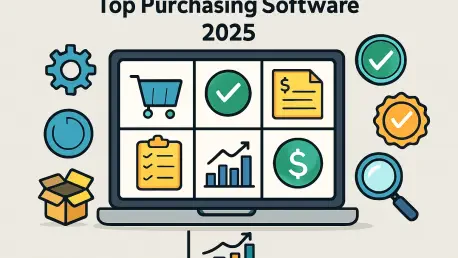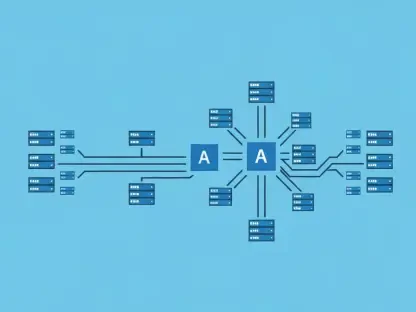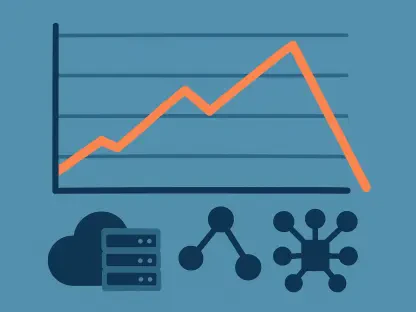In an era where businesses are racing to optimize every operational facet, purchasing software has emerged as a vital tool for transforming procurement from a cumbersome chore into a streamlined process. The urgency to ditch outdated methods like spreadsheets, which often lead to delayed approvals and budget mishaps, has never been more pronounced. Companies of all sizes are grappling with vendor management issues and fragmented systems that frustrate both staff and suppliers. This deep dive into the leading purchasing software, as evaluated through G2 reviews, aims to illuminate the path for CFOs, procurement leaders, and operations directors seeking digital solutions. The focus is on tools that centralize orders, automate workflows, and bolster financial oversight, ensuring that businesses can address inefficiencies head-on with confidence.
The insights presented here stem from a meticulous analysis of user feedback on G2, a trusted platform for authentic software reviews, combined with market trends and expert perspectives. Six standout tools have been scrutinized to uncover their strengths, limitations, and real-world impact. Whether a business operates on a global scale or within a mid-sized niche, aligning software capabilities with specific pain points is paramount. Automation, real-time data access, and seamless integration are not just buzzwords but critical components that users repeatedly emphasize in their evaluations. The goal is to provide clarity in a crowded market, helping decision-makers invest in solutions that deliver measurable value without exacerbating existing challenges.
A striking aspect of G2 reviews is the raw emotion behind user feedback, capturing the frustration of manual delays and the relief of finding a tool that simplifies complex tasks. These human experiences add a layer of depth to the technical assessments, highlighting that software selection is as much about empowering teams as it is about features. From multinational corporations needing robust systems to startups craving simplicity, the diversity of needs is vast. This analysis prioritizes user-validated insights over marketing claims, ensuring that the recommendations reflect practical performance. Navigating the balance between functionality and usability remains a central theme, as the wrong choice can deepen inefficiencies rather than resolve them.
Key Trends Shaping Purchasing Software
Automation as the Core Standard
Automation has solidified its position as the backbone of modern purchasing software, with businesses demanding tools that eliminate the drudgery of manual processes. G2 reviews consistently highlight the transformative effect of automating purchase order creation, approval routing, and invoice matching. These capabilities are no longer seen as optional but as fundamental to maintaining a competitive edge. Tools that fail to deliver seamless automation receive sharp criticism from users who experience firsthand the cost of errors and delays. The consensus is clear: in a fast-paced business environment, automation is the baseline for efficiency, allowing teams to focus on strategic priorities rather than repetitive tasks.
Beyond error reduction, automation reshapes the daily experience of procurement teams, as evidenced by G2 feedback. Users often describe a noticeable shift when software takes over time-intensive duties, freeing up hours for analysis and planning. This shift isn’t just about speed but also about reducing stress and enhancing accuracy in financial tracking. The tools that excel in this area are often praised for their ability to adapt workflows to unique business rules, ensuring that automation doesn’t come at the expense of control. Such adaptability is a recurring point of satisfaction, underscoring why this feature tops the list of non-negotiables for companies of all sizes.
Real-Time Spend Visibility for Better Decisions
Equally critical in G2 evaluations is the demand for real-time spend visibility, a feature that empowers finance teams to monitor budgets with precision. Users frequently commend software that provides instant dashboards, revealing spending patterns and potential overruns before they escalate. This capability is seen as a safeguard against financial missteps, offering clarity that delayed or manual reporting cannot match. Businesses rely on these insights to make informed decisions swiftly, a need that resonates across industries. Tools that lag in delivering up-to-the-minute data often face user frustration, as delayed information can derail budget adherence.
The value of real-time visibility extends far beyond mere numbers, fostering a sense of control among decision-makers, as reflected in G2 reviews. Knowing where every dollar is allocated at any given moment allows for proactive adjustments, a feature that users describe as indispensable for maintaining fiscal discipline. This isn’t just about tracking expenses but about aligning purchases with strategic goals without constant manual intervention. Software that integrates this visibility with actionable alerts or notifications tends to score higher, as it bridges the gap between data and decision. The trend underscores a broader shift toward data-driven procurement, where immediacy is as vital as accuracy.
In-Depth Analysis of Leading Software Solutions
SAP AribEnterprise-Grade Procurement Leader
SAP Ariba stands out in G2 reviews as a powerhouse for large enterprises, boasting a satisfaction score of 85 and earning high marks for its comprehensive procurement capabilities. Its ability to manage the entire lifecycle—from sourcing to invoicing—makes it a go-to for organizations with intricate vendor networks. Users appreciate the centralized database that streamlines supplier interactions and the deep integration with ERP systems, which ensures smooth data flow across operations. Customizable approval workflows are frequently cited as a strength, allowing businesses to tailor processes to complex hierarchies. However, the initial learning curve is often described as steep, with some users noting that the interface can feel outdated despite its robust functionality.
Despite setup challenges, the long-term benefits of SAP Ariba resonate with G2 reviewers, particularly for those who have mastered its intricacies. The software’s capacity to handle real-time invoice tracking and contract management is seen as a game-changer for maintaining financial transparency in sprawling operations. Users in regulated industries often highlight the value of built-in compliance features, which reduce the risk of policy breaches. While the onboarding phase can be resource-intensive, feedback suggests that the efficiency gains and scalability justify the effort for enterprises with the capacity to invest. This balance of power and complexity positions it as a top contender for businesses prioritizing depth over immediate simplicity.
Procurify: Agile Spend Management for Mid-Sized Firms
Procurify earns a stellar 90 satisfaction score on G2, making it a favorite among mid-market companies seeking intuitive spend management. Its strength lies in delivering real-time visibility into budgets, allowing teams to catch potential overspending before approvals are finalized. The user-friendly interface is a frequent point of praise, ensuring that even non-finance staff can navigate purchasing processes with ease. Additionally, the mobile app mirrors desktop functionality, a feature that users value for its accessibility on the go. While minor glitches in the app are occasionally mentioned, the overall consensus points to a tool that simplifies procurement without overwhelming users.
Customer support emerges as a standout aspect of Procurify in G2 feedback, with many users noting rapid responses even during off-hours. This responsiveness enhances trust, especially for businesses new to digital procurement tools, as it mitigates the fear of being left stranded with technical issues. The software’s cloud-based deployment further adds to its appeal, offering scalability without the need for extensive IT infrastructure. Although it may not handle highly complex workflows as seamlessly as enterprise solutions, its agility and straightforward design make it a practical choice for firms focused on operational efficiency. Procurify’s balance of functionality and simplicity resonates deeply with its target audience.
SAP S/4HANA Cloud: Robust ERP-Driven Automation
SAP S/4HANA Cloud, despite a modest satisfaction score of 56 on G2, commands a near-perfect market presence score of 99, reflecting its dominance in ERP-integrated environments. Tailored for businesses with complex operational needs, it excels in automating purchase orders and integrating accounting processes seamlessly. The embedded analytics and real-time data capabilities via its modern interface are often highlighted as key differentiators, enabling precise inventory and invoicing updates. Users in large organizations value its connectivity with CRM and supply chain modules, which creates a unified operational ecosystem. However, the high cost and lengthy implementation timeline are frequent criticisms.
Feedback on G2 also points to a significant learning curve with SAP S/4HANA Cloud, which can deter smaller teams or those with limited resources for training. However, for enterprises willing to commit, the scalability and depth of automation offer substantial long-term value, as noted by many reviewers. The ability to handle intricate workflows and maintain audit readiness through detailed tracking is a recurring positive in evaluations. While not ideal for every business due to its complexity, it remains a top choice for organizations already embedded in the SAP ecosystem or those requiring robust, scalable solutions. Its focus on integration and automation cements its relevance for specific high-demand use cases.
Emburse Expense Professional: Streamlined Expense Handling
Emburse Expense Professional garners a strong 90 satisfaction score on G2, excelling in the niche of expense management and receipt processing. Its intuitive mobile app allows users to upload receipts effortlessly through multiple methods, saving time on administrative tasks. The automated approval workflows are frequently praised for reducing back-office bottlenecks, ensuring that expense reporting doesn’t become a burden. Compliance with expense policies is another area where it shines, offering peace of mind to businesses in regulated sectors. However, some users note challenges with ERP integrations, which can require manual workarounds.
Beyond its core strengths, Emburse Expense Professional is valued on G2 for its ability to simplify what is often a frustrating aspect of financial management. Reviewers frequently mention the relief of having a tool that handles receipt capture and categorization with minimal input, allowing them to focus on higher-priority tasks. While occasional issues with autofill accuracy or receipt editing are noted, the overall user sentiment leans toward appreciation for its focused functionality. For teams where expense tracking takes precedence over broader procurement needs, this software stands out as a practical, user-centric option. Its targeted approach ensures relevance for specific operational pain points.
Airbase: Innovative Payment and Spend Integration
Airbase, with a G2 satisfaction score of 79, is celebrated for its innovative approach to spend management through smart payment solutions like virtual and physical cards. Its real-time reporting capabilities provide transparency into company-wide expenditures, a feature that finance teams on G2 frequently commend. Seamless integrations with ERP systems ensure that data flows without duplication, reducing reconciliation efforts. Customizable approval workflows add another layer of control, aligning purchases with policy. However, initial setup complexity and minor categorization inaccuracies are noted drawbacks in user feedback.
G2 reviews also highlight Airbase’s strength in fostering modern financial operations, particularly for teams looking to digitize payment processes. The intuitive interface is often described as a breath of fresh air compared to clunkier alternatives, encouraging adoption across departments. Users appreciate the clarity it brings to spend tracking, which helps in maintaining budget discipline without constant oversight. While it may not support native recurring payments as robustly as some competitors, its focus on transparency and integration makes it a compelling choice for businesses prioritizing payment efficiency. Airbase’s forward-thinking design addresses a critical need in today’s digital-first environment.
Teampay: Efficient Approvals and Policy Control
Teampay leads with an impressive 95 satisfaction score on G2, recognized for its streamlined approach to purchase order automation and real-time approvals. Its pre-approval mechanisms ensure compliance before spending occurs, a feature that users in policy-driven environments find invaluable. Integrations with collaboration tools like Slack enhance accessibility, while virtual cards simplify one-time purchases. Customer support is another area of consistent praise, with reviewers noting proactive updates and quick resolutions. Some limitations, such as visibility into delayed approvals, are mentioned but rarely overshadow the overall positive sentiment.
The emphasis on compliance and efficiency in Teampay resonates strongly with G2 users, many of whom describe it as a tool that aligns purchasing with organizational rules effortlessly. The ability to maintain audit trails in real time adds a layer of security, particularly for businesses concerned with documentation. Reviewers also value the ongoing feature enhancements, which reflect a responsiveness to user needs that isn’t always seen in competitors. While it may not focus heavily on reimbursement processes, its strength in approval workflows and policy enforcement makes it a top pick for firms seeking control without complexity. Teampay’s design prioritizes practical, immediate impact for purchasing teams.
Strategies for Selecting the Ideal Purchasing Tool
Aligning Software with Organizational Scale
Choosing the right purchasing software begins with a clear assessment of business size and operational scope, as underscored by G2 user insights. Large enterprises with global operations often gravitate toward comprehensive solutions like SAP Ariba, which can manage intricate procurement cycles despite a challenging setup. Mid-sized companies, on the other hand, find value in agile platforms like Procurify or Teampay, where speed and simplicity take precedence over exhaustive features. Smaller firms might lean toward Airbase for its straightforward design and lower entry barriers. Matching software depth to organizational needs ensures that investments yield efficiency rather than frustration.
Scale also influences the complexity of workflows a business can support, a point frequently raised in G2 feedback. Enterprises have the resources to navigate extended training for tools with vast capabilities, while smaller entities prioritize quick deployment to address immediate pain points. This distinction is critical, as a mismatch can lead to underutilized software or overwhelmed teams. Reviewers often stress the importance of trialing tools to gauge fit before full commitment, especially for firms in growth phases. Understanding the operational context—whether it’s a sprawling supply chain or a tight-knit startup—guides a selection process that aligns with both current demands and future expansion.
Balancing Cost with Long-Term Returns
Cost remains a pivotal consideration in software selection, with G2 reviews often dissecting the trade-offs between price and value. Enterprise-grade tools like SAP S/4HANA Cloud carry significant upfront costs, yet users in large organizations argue that the return on investment justifies the expense through scalability and automation gains. Mid-tier solutions like Emburse Expense Professional offer more accessible pricing, appealing to budget-conscious firms without sacrificing core functionality. Feedback consistently advises evaluating the total cost of ownership, including training and maintenance, against the expected financial and operational benefits.
Beyond sticker price, G2 users emphasize the hidden costs of choosing the wrong tool, such as wasted time or lost productivity due to poor performance. A cheaper option that fails to deliver can ultimately drain resources more than a pricier, reliable system. Reviewers suggest mapping out specific pain points—like manual errors or delayed approvals—and estimating the cost savings a tool might bring in those areas. This analytical approach helps in prioritizing features over initial affordability, ensuring that the chosen software contributes to fiscal health over time. Budget alignment, paired with a focus on measurable outcomes, forms the bedrock of a sound purchasing decision.
Emphasizing Integration and Support Quality
Integration with existing systems like ERP or accounting platforms emerges as a non-negotiable factor in G2 evaluations, directly impacting software effectiveness. Tools that sync seamlessly with solutions like QuickBooks or SAP prevent data silos and reduce manual reconciliation, a benefit that users frequently highlight. Airbase and SAP Ariba, for instance, are often praised for their robust connectivity, which minimizes disruption to established tech stacks. Conversely, software with clunky integrations draws criticism for creating more work, underscoring the need to verify compatibility before adoption.
Equally important is the quality of customer support, which can make or break the user experience, according to G2 feedback. Responsive teams, as seen with Procurify and Teampay, provide reassurance during implementation hiccups or technical glitches, often turning potential frustrations into positive outcomes. Users value proactive communication and weekend availability, which ensure that issues don’t stall operations. Software backed by strong support tends to foster greater trust, encouraging wider adoption within teams. Prioritizing both integration and reliable assistance ensures that the tool enhances rather than hinders daily workflows.
Focusing on User Adoption and Training Needs
User adoption is a critical determinant of software success, with G2 reviews consistently tying ease of use to overall satisfaction. Tools with intuitive interfaces, such as Procurify, encourage engagement across departments, including non-finance staff, thereby reducing rogue spending and policy violations. Conversely, complex systems like SAP S/4HANA Cloud often require extensive training, which can delay rollout and frustrate users if not managed well. Feedback suggests that accessibility drives compliance, as employees are more likely to follow processes when the tool feels approachable and supportive of their daily tasks.
Training requirements also play a significant role in adoption, as highlighted by G2 users who stress the importance of manageable learning curves. Software that demands weeks of onboarding can sap morale and resources, particularly for smaller teams lacking dedicated IT support. Reviewers often recommend seeking tools with built-in tutorials or guided experiences to ease the transition. Additionally, involving end-users in the selection process can uncover potential usability barriers early, ensuring that the chosen system aligns with team capabilities. A focus on user-friendliness and realistic training expectations paves the way for seamless integration into existing operations.
Reflecting on the Path Forward for Procurement Solutions
Navigating Future Needs with Scalable Tools
Looking back, the journey through G2 reviews revealed that scalability stood as a defining factor in the success of purchasing software for businesses of varying sizes. Tools like SAP Ariba and SAP S/4HANA Cloud demonstrated their capacity to grow alongside enterprises, adapting to expanding workflows over time. Meanwhile, solutions such as Teampay and Airbase proved their worth for smaller or mid-sized firms by offering flexibility without overwhelming complexity. The feedback captured a shared understanding that anticipating future growth was just as critical as addressing current inefficiencies. Decision-makers were guided to consider not only today’s challenges but also the potential demands of tomorrow when selecting a tool.
Leveraging User Insights for Continuous Improvement
Reflecting on the analysis, it became evident that G2 user insights played a pivotal role in shaping a nuanced view of each software’s real-world impact. The candid feedback on aspects like customer support responsiveness and integration challenges provided a roadmap for vendors to refine their offerings. Businesses, in turn, benefited from this transparency by setting realistic expectations around implementation timelines and training needs. Moving forward, leveraging such community-driven data will remain essential for both users and developers, fostering a cycle of improvement. The next step involves actively monitoring evolving user needs and emerging features to ensure that procurement tools continue to align with dynamic business landscapes.









